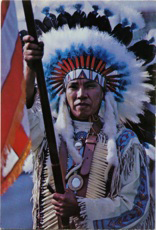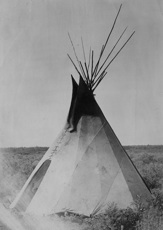Demographics
 The Uintah and Ouray Reservation is located in Fort Duchesne approximately 150 miles east of Salt Lake City. There are around 3,157 tribal members, and the reservation rests within a three-county area known as the “Uintah Basin.” The reservation covers over 4.5 million acres and is the second largest Indian reservation in the United States. Three bands of Utes comprise the Northern Ute tribe: the Whiteriver, Uncompahgre, and Uintah. The Uintah Band was first to call the Uintah Basin their home;later the Whiteriver and Uncompahgre bands were removed from Colorado to the Uintah Valley Reservation, thus creating the Uintah and Ouray Reservation. The governing Ute body uses the band system. Each band elects two representatives to four-year terms in two-year cycles.
The Uintah and Ouray Reservation is located in Fort Duchesne approximately 150 miles east of Salt Lake City. There are around 3,157 tribal members, and the reservation rests within a three-county area known as the “Uintah Basin.” The reservation covers over 4.5 million acres and is the second largest Indian reservation in the United States. Three bands of Utes comprise the Northern Ute tribe: the Whiteriver, Uncompahgre, and Uintah. The Uintah Band was first to call the Uintah Basin their home;later the Whiteriver and Uncompahgre bands were removed from Colorado to the Uintah Valley Reservation, thus creating the Uintah and Ouray Reservation. The governing Ute body uses the band system. Each band elects two representatives to four-year terms in two-year cycles.
History
 Ute tradition suggests that the Ute people were brought here by the god Sinauf. Anthropologists argue that the Utes migrated to the northern Colorado Plateau between one and two thousand years ago. Historically, the Ute people lived in family groups, or bands, which were independent but bound by a common language and close trade and social relationships. The Ute people engaged in a sophisticated gathering and hunting economy, living on seeds, berries, roots, deer, rabbits, birds, and fish.
Ute tradition suggests that the Ute people were brought here by the god Sinauf. Anthropologists argue that the Utes migrated to the northern Colorado Plateau between one and two thousand years ago. Historically, the Ute people lived in family groups, or bands, which were independent but bound by a common language and close trade and social relationships. The Ute people engaged in a sophisticated gathering and hunting economy, living on seeds, berries, roots, deer, rabbits, birds, and fish.
The introduction of the horse in the 1600s brought major changes to the Ute way of life, allowing the Utes to travel farther and more quickly. The Utes began to adopt many aspects of Plains Indian culture and developed trade relationships with the Spanish and tribes that were once out of reach.
Contact with the Spanish starting in the seventeenth century altered Ute life, introducing the slave trade and exacerbating tribal rivalries. Further disruption to Ute life came with the arrival of LDS settlers, who expanded quickly into Ute territory and competed for natural resources. The Utes frequently retaliated against encroaching settlers with raids
Following several armed conflicts with Mormon settlers, the Utes reluctantly signed the Treaty of Spanish Fork in 1865 and were forced to relocate to the arid Uintah Basin. In 1881 the federal government forcibly removed the Yamparka and Parianuc (White River) Utes from Colorado to the Uintah Reservation. The next year the federal government established the Uncompahgre (later renamed Ouray) Reservation adjacent to the Uintah Reservation and moved the Taviwac (Uncompahgre) Utes to this remote, dry area. The two reservations were consolidated in 1886.
By 1933, ninety-one percent of the reservation lands had been taken as a result of allotment. Allotment made the traditional Ute lifestyle impossible. Attempts at farming proved disastrous due to cultural resistance and competition from better-equipped and more experienced white neighbors, so the Utes turned to raising sheep, cattle and horses. In 1906, as an act of protest to bad government policy, a group of Utes trekked to South Dakota hoping that the Sioux would join in their defiance. The Sioux refused, and after two years of little rations or support, the federal government escorted the Utes back to their reservation.
In the 1950s Utes from all areas won a series of legal battles and received $32 million in reparations for land losses. Today the Utes operate several businesses, raise cattle, and mine oil and natural gas. The Northern Ute Tribe continually strives to maintain their language and culture while also developing the economy and education of the tribal members.
Language and Culture
The Utes are part of the Southern Numic speakers of the Numic language family. They are exceptional artists and create beautiful examples of religious and ceremonial beadwork and leatherwork. The Utes love horses and frequently incorporate horses into their art and culture, creating, for example, intricate saddles and paintings. They also adopted aspects of Plains Indian culture, such as elaborate headdresses, costumes, and tipis.
The Utes tell the legend of Sinauf, a god who is half man and half wolf. Sinauf and his brothers Coyote and Wolf kept the world in balance before the world was created. Sinauf made people and gave humans the responsibility to care for the world. Legends of Sinauf and his first creations are the basis of Ute belief and help to define the important relationship of the Ute people with the spiritual and physical elements of life. Medicine men were Ute religious leaders because the power of healing was an important aspect of Ute life. The medicine man used abilities bestowed upon him by spiritual or natural powers to help other band members.
The Utes celebrate the Bear Dance to celebrate the coming of spring and the awakening of animals from their long hibernation. The Bear Dance brought Ute bands together to enjoy the abundance spring provided. It was a time for trade and courtship and continues to be the main social event of the Ute tribe. The Utes also adopted the Sun Dance and Peyoteism during the 1890s to strengthen their spiritual ties to their land and ancestry.





